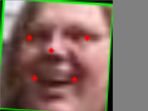使用dlib进行人脸检测和人脸特征点提取异以及人脸识别
默认环境为Windows10+anaconda+python3.7
准备工作
下载安装dlib
- 要想使用dlib首先要下载安装dlib三方库,下载地址在这里,下载后在文件所在目录pip install xxxx.whl即可。
安装所需模型
模型下载地址如下
代码实现
人脸检测
#检测人脸后将人脸框起来
import dlib
import numpy as np
import cv2
import math
#
def rect_to_xywh(rect): # 获得人脸矩形的坐标信息
x = rect.left()
y = rect.top()
w = rect.right() - x
h = rect.bottom() - y
return (x, y, w, h)
def detect(size):
image_file = "test.jpg"#打开待检测图片
detector = dlib.get_frontal_face_detector()
image = cv2.imread(image_file)
height,width = image.shape[:2]
height = math.ceil(size*height)
width = math.ceil(size*width)
image = cv2.resize(image,(width,height),interpolation=cv2.INTER_LINEAR)#使用cv2自带的函数resize图片,后面参数表示插值方式
gray = cv2.cvtColor(image, cv2.COLOR_BGR2GRAY)#转换为灰度图
# cv2.imshow("Output1", gray)
rects = detector(gray, 1)#在灰度图上面进行操作
for (i, rect) in enumerate(rects):
(x, y, w, h) = rect_to_xywh(rect)
cv2.rectangle(image, (x, y), (x + w, y + h), (255, 255, 255), 2)
cv2.putText(image, "Face: {}".format(i + 1), (x - 10, y - 10), cv2.FONT_HERSHEY_SIMPLEX, 0.5, (0, 255, 0), 2)
cv2.imshow("Output", image)
cv2.waitKey(0)
if __name__ == "__main__":
size = 1/2#指定缩放图片的比例,1/2表示将长宽各缩小一半
detect(size)
结果如下:
人脸特征点提取
# encoding:utf-8
import dlib
import numpy as np
import cv2
import math
def rect_to_bb(rect): # 获得人脸矩形的坐标信息
x = rect.left()
y = rect.top()
w = rect.right() - x
h = rect.bottom() - y
return (x, y, w, h)
def shape_to_np(shape, dtype="int"): # 将包含68个特征的的shape转换为numpy array格式
coords = np.zeros((68, 2), dtype=dtype)
for i in range(0, 68):
coords[i] = (shape.part(i).x, shape.part(i).y)
return coords
def feature(size):
image_file = "test1.jpg"
detector = dlib.get_frontal_face_detector()
predictor = dlib.shape_predictor("shape_predictor_68_face_landmarks.dat")
image = cv2.imread(image_file)
width,height = image.shape[:2]
height,width = math.ceil(size*height),math.ceil(size*width)
image = cv2.resize(image,(height,width),interpolation=cv2.INTER_LINEAR)
gray = cv2.cvtColor(image, cv2.COLOR_BGR2GRAY)
rects = detector(gray, 1)
shapes = []
for (i, rect) in enumerate(rects):
shape = predictor(gray, rect)
shape = shape_to_np(shape)
shapes.append(shape)
(x, y, w, h) = rect_to_bb(rect)
cv2.rectangle(image, (x, y), (x + w, y + h), (0, 255, 0), 2)
cv2.putText(image, "Face: {}".format(i + 1), (x - 10, y - 10), cv2.FONT_HERSHEY_SIMPLEX, 0.5, (0, 255, 0), 2)
for shape in shapes:
for (x, y) in shape:
cv2.circle(image, (x, y), 2, (0, 0, 255), -1)
cv2.imshow("Output", image)
cv2.waitKey(0)
if __name__ == "__main__":
size = 2
feature(size)
结果如下:
人脸对齐
# encoding:utf-8
import dlib
import cv2
import matplotlib.pyplot as plt
import numpy as np
import math
def rect_to_bb(rect): # 获得人脸矩形的坐标信息
x = rect.left()
y = rect.top()
w = rect.right() - x
h = rect.bottom() - y
return (x, y, w, h)
def face_alignment(faces):
predictor = dlib.shape_predictor("shape_predictor_68_face_landmarks.dat") # 用来预测关键点
faces_aligned = []
for face in faces:
rec = dlib.rectangle(0,0,face.shape[0],face.shape[1])
shape = predictor(np.uint8(face),rec) # 注意输入的必须是uint8类型
order = [36,45,30,48,54] # left eye, right eye, nose, left mouth, right mouth 注意关键点的顺序,这个在网上可以找
for j in order:
x = shape.part(j).x
y = shape.part(j).y
cv2.circle(face, (x, y), 2, (0, 0, 255), -1)
eye_center =((shape.part(36).x + shape.part(45).x) * 1./2, # 计算两眼的中心坐标
(shape.part(36).y + shape.part(45).y) * 1./2)
dx = (shape.part(45).x - shape.part(36).x) # note: right - right
dy = (shape.part(45).y - shape.part(36).y)
angle = math.atan2(dy,dx) * 180. / math.pi # 计算角度
RotateMatrix = cv2.getRotationMatrix2D(eye_center, angle, scale=1) # 计算仿射矩阵
RotImg = cv2.warpAffine(face, RotateMatrix, (face.shape[0], face.shape[1])) # 进行放射变换,即旋转
faces_aligned.append(RotImg)
return faces_aligned
def demo(size):
image = cv2.imread('test1.jpg').astype('uint8')
height,width = image.shape[:2]
height, width = math.ceil(size*height),math.ceil(size*width)
image = cv2.resize(image, (width, height), interpolation=cv2.INTER_LINEAR)
detector = dlib.get_frontal_face_detector()
gray = cv2.cvtColor(image, cv2.COLOR_BGR2GRAY)
rects = detector(gray, 1)
src_faces = []
for (i, rect) in enumerate(rects):
(x, y, w, h) = rect_to_bb(rect)
detect_face = image[y:y+h,x:x+w]
src_faces.append(detect_face)
cv2.rectangle(image, (x, y), (x + w, y + h), (0, 255, 0), 2)
cv2.putText(image, "Face: {}".format(i + 1), (x - 10, y - 10), cv2.FONT_HERSHEY_SIMPLEX, 0.5, (0, 255, 0), 2)
faces_aligned = face_alignment(src_faces)
cv2.imshow("src", image)
i = 0
for face in faces_aligned:
cv2.imshow("det_{}".format(i), face)
i = i + 1
cv2.waitKey(0)
if __name__ == "__main__":
size = 3
demo(size)
# encoding:utf-8
import dlib
import cv2
import matplotlib.pyplot as plt
import numpy as np
import math
import os, glob
from skimage import io
def create_face_space():
# 对文件夹下的每一个人脸进行:
# 1.人脸检测
# 2.关键点检测
# 3.描述子提取
# 候选人脸文件夹
faces_folder_path = "candidate-faces/"
# 候选人脸描述子list
descriptors = []
for f in glob.glob(os.path.join(faces_folder_path, "*.jpg")):
# print(f)
print("Processing file: {}".format(f))
img = io.imread(f)
# 1.人脸检测
dets = detector(img, 1)
print("Number of faces detected: {}".format(len(dets)))
for k, d in enumerate(dets):
# 2.关键点检测
shape = sp(img, d)
# 3.描述子提取,128D向量
face_descriptor = facerec.compute_face_descriptor(img, shape)
# 转换为numpy array
v = np.array(face_descriptor)
descriptors.append(v)
return descriptors
def predict(descriptors,path):
# 对需识别人脸进行同样处理
# 提取描述子
img = io.imread(path)
dets = detector(img, 1)
dist = []
for k, d in enumerate(dets):
shape = sp(img, d)
face_descriptor = facerec.compute_face_descriptor(img, shape)
d_test = np.array(face_descriptor)
# 计算欧式距离
for i in descriptors:
dist_ = np.linalg.norm(i-d_test)
dist.append(dist_)
return dist
def demo():
global detector, sp, facerec
# 加载正脸检测器
detector = dlib.get_frontal_face_detector()
# 加载人脸关键点检测器
sp = dlib.shape_predictor("shape_predictor_68_face_landmarks.dat")
# 3. 加载人脸识别模型
facerec = dlib.face_recognition_model_v1("dlib_face_recognition_resnet_model_v1.dat")
descriptors = create_face_space()
# print(descriptors)
# 候选人名单
candidate = ['liushishi','liuyifei', 'tangyan', 'tongliya', 'yangzi','zhaoliying',]
test_path = "test--faces/"
for f in glob.glob(os.path.join(test_path, "*.jpg")):
print(f)#测试后得出结论,f没问题,文件可以读取到.
dist = predict(descriptors, f)
# print(descriptors)
# 候选人和距离组成一个dict
c_d = dict(zip(candidate, dist))
# print(c_d)
cd_sorted = sorted(c_d.items(), key=lambda d:d[1])
print("The person_{} is: ".format(f),cd_sorted[0][0])
if __name__ == "__main__":
demo()
识别结果很差,简直全错,不知道为什么 .还没搞清楚…




